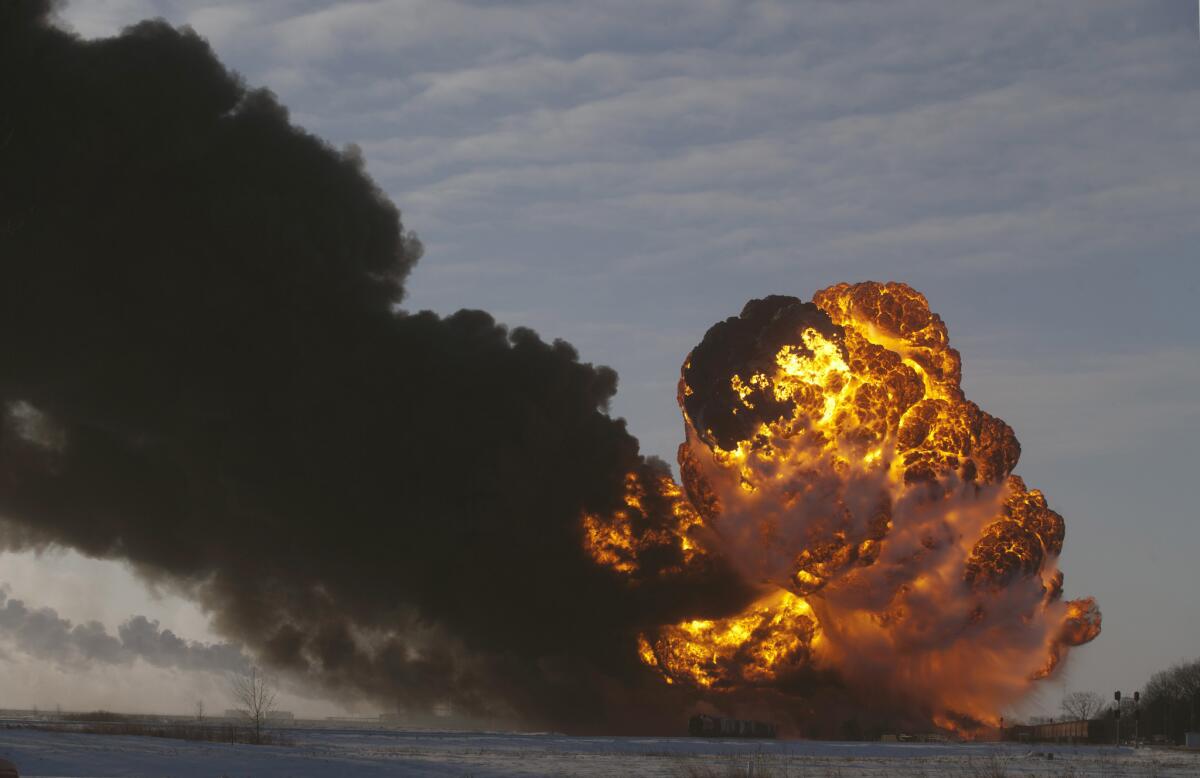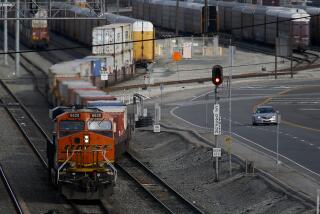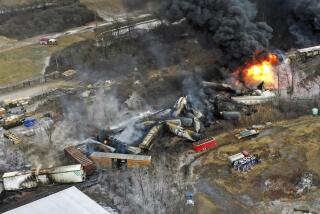Railroad industry agrees to new safety measures for hauling crude

After a spate of high-profile accidents, the railroad industry agreed with government regulators Friday to reduce speeds on trains carrying crude, conduct more frequent track inspections and improve braking by July.
The measures come on top of an effort by the Department of Transportation to upgrade tank car safety and an emergency order last year to tighten operating procedures on trains that can haul about 100 tank cars at a time across long stretches.
The response comes after a handful of major North American crashes of oil trains that set off fires and explosions, the worst one killing 47 people in the Canadian town of Lac-Megantic, Quebec, Canada, last summer. Since then, crashes have occurred in Alabama; North Dakota; Alberta, Canada; and Pennsylvania.
Transportation Secretary Anthony Foxx signed the agreement with the Assn. of American Railroads, laying out eight specific measures that were intended to raise âthe safety bar.â
âSafety is our top priority, and we have a shared responsibility to make sure crude oil is transported safely from origin to destination,â Foxx said in a statement. âTodayâs changes will enhance safety while we continue to pursue our comprehensive approach focused on prevention, mitigation and emergency response through collaboration with our partners.â
The most significant action would reduce the maximum speed of crude trains from 50 mph to 40 mph in âhigh threat urban areas.â That reduction could have broad nationwide ramifications on the speeds of other freight, because trainsâ movements are highly coordinated to maximize the use of track.
âIt will impact velocity across the network,â AAR president Edward Hamberger said in an interview. âIt stretches resources a little bit.â
Hamberger agreed with outside experts who say the railroad industry has gotten a âbad rapâ on carrying crude, but said the measures should further improve safety and address âa risk of having a loss of confidence in the communities where we operate.â
Indeed, BNSF Railway is still cleaning up the mess in Casselton, N.D., where a train with more than 100 tank cars struck another derailed train and caused an explosion that required the evacuation of much of the town.
Hamberger acknowledged that a ânatural tensionâ has developed between shippers of crude and the railroad industry. âI have heard more than once if you would just keep the train on the tracks, we wouldnât have a problem.â
In the rail industryâs view, however, the crude represents a higher-risk product and therefore should be a shared responsibility.
âWhat I am trying to get away from is our industry pointing the finger,â he said.
And shippers do have a legitimate point that the accidents have not been their fault, added Brigham McCown, former head of the Pipeline and Hazardous Material Safety Administration. âIf an Amtrak derails, do you blame the passengers?â he said.
The association was the lead on making the agreement with the Transportation Department, but all seven major railroads who are members individually approved the deal.
McCown said the new safety measures could raise the costs of shipping oil by rail enough to make it less competitive. Oil produced in the North Dakota Bakken field can be shipped by pipeline for $5 per barrel, while rail costs $12 to $15 per barrel, even before the latest safety measures, he said.
âThe tug of war is over cost,â he said.
The slower speeds should allow trains to stop much faster if there is an obstruction on the track and reduce the probability of a derailment in extremely hot or cold weather. If there is a derailment, slower speeds should also reduce the number of cars that leave the track and reduce the probability that tank cars will leak.
In addition to the speed reduction, the industry agreed to improve braking by making sure all crude trains operate with locomotives in the middle or at the end of the trains, conduct at least two track inspections per year on lines where oil trains move, install special detectors that can spot overheated wheel bearings on train cars, develop an inventory of resources that are available to respond to emergencies, pledge $5 million to a training program for first responders and continue to address community concerns.
Follow LATimes National on Facebook
ALSO:
To these scribes, writing about dogs isnât for the dogs
Cold temperatures, roof collapses mark winterâs latest icy turn
5-month-old revived in Florida highway drama; baby critical but stable
More to Read
Sign up for Essential California
The most important California stories and recommendations in your inbox every morning.
You may occasionally receive promotional content from the Los Angeles Times.











